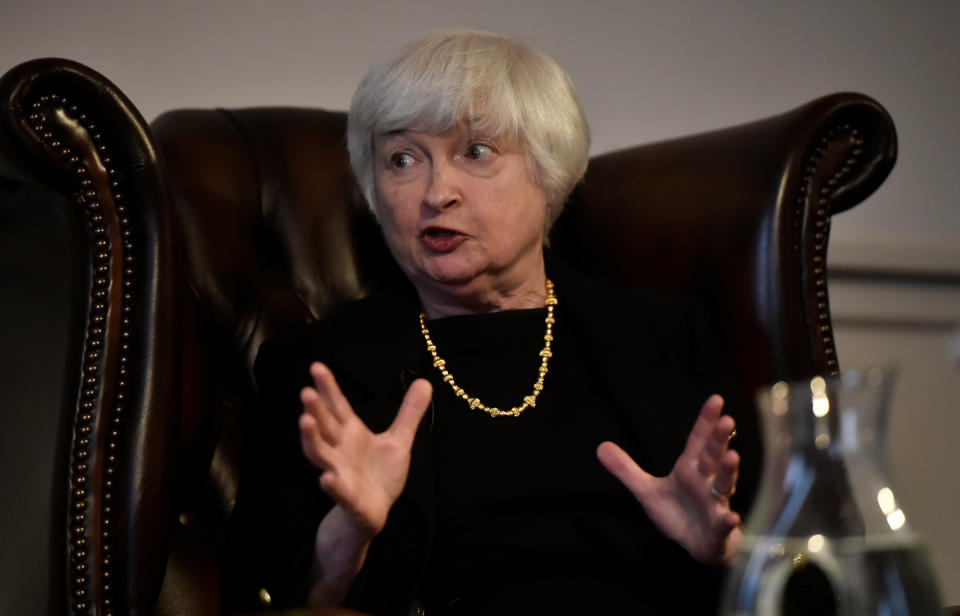Fed sees easing financial conditions despite tightening
The latest minutes from the Federal Reserve’s mid-June meeting, released on Wednesday afternoon, revealed that the Fed acknowledges financial conditions have eased despite reduced policy accommodation.
“Participants observed that, over the intermeeting period, equity prices rose, longer-term interest rates declined, and volatility in financial markets was generally low,” according to the minutes.
Investors have been trying to decipher if the Fed’s underlying tone is “hawkish,” which would suggest a higher likelihood of aggressive tightening, despite recent concerns including low inflation readings and softer economic data.
The scrutiny on the Fed’s tone grew stronger following the Fed’s decision to boost its benchmark interest rate 25 basis points in June for the second time this year, particularly as central bankers across the world expressed more hawkish commentary.
Following the release of the minutes, bond yields rose to a seven-week high and market expectations for the fed funds rate also increased, suggesting the market is pricing in tighter Fed policy this year.
Some participants said stock prices were ‘high’
When Fed participants discussed why financial conditions had not tightened, the conversation turned to asset prices.
“Participants discussed possible reasons why financial conditions had not tightened. Corporate earnings growth had been robust; nevertheless, in the assessment of a few participants, equity prices were high when judged against standard valuation measures,” according to the minutes.

In other words, it seems the Fed has been looking beyond merely its dual mandate of achieving stable prices and maximizing sustainable employment.
“Some participants suggested that increased risk tolerance among investors might be contributing to elevated asset prices more broadly,” according to the minutes. “A few participants expressed concern that subdued market volatility, coupled with a low equity premium, could lead to a buildup of risks to financial stability.”
Last week, public statements from Fed officials focused on the markets and valuation.
San Francisco Federal Reserve Bank President John Williams said the stock market is “running on fumes,” Yellen mentioned “somewhat rich” asset prices, and Federal Reserve Vice Chairman Stanley Fischer warned against complacency.
And RBC’s chief US economist Tom Porcelli said this focus on valuation makes sense.
“What we learned not only from the last cycle (the housing bust) but from the one before that (the pop of the internet bubble and subsequent credit dislocations) is that dis-inflation is not what ultimately takes the economy down. It is about asset bubbles that, one could argue, were led on by ultra-easy monetary policy and then pricked by tightening on the follow,” Porcelli wrote in a recent note.
“If markets are indeed overvalued,” Porcelli wrote, “the Fed’s attempt to engineer a soft landing of asset prices or even prevent an overheating of these by removing accommodation is completely consistent behavior for a committee that has been burned by bubbles in the past.”
The inflation question
A key question for investors has been the Fed’s future view of inflation, which Janet Yellen said has been pushed lower by “one-off reductions” including declines in prescription drug prices and wireless telephone bills.
The minutes revealed mixed views over just how temporary low inflation really is.
“Several participants expressed concern that progress toward the Committee’s 2% longer-run inflation objective might have slowed and that recent softness in inflation might persist,” according to the minutes.
Last week, the Commerce Department’s Personal Consumption Expenditures (PCE) index slowed to 1.4% in May, building on the disappointing consumer price index (CPI) reading from June 14.
Fed officials also were mixed on where they stand with their second mandate, maximizing employment.
“Several participants endorsed a policy approach..in which the unemployment rate would undershoot their current estimates of the longer-term normal rate for a sustained period,” the minutes said. On the other hand, “several participants expressed concern that a substantial and sustained unemployment undershooting might make the economy more likely to experience financial instability or could lead to a sharp rise in inflation.”
The scrutiny on the mixed signals of inflation and employment is also heightened ahead of Friday’s jobs report, with the unemployment rate expected to remain at 4.3%, which many economists call “full employment” that could eventually put upward pressure on wages.
Considering the loose financial conditions, also discussed during the latest Fed meeting, there may be room to be aggressive, according to some analysts.
In addition to raising rates, the Fed is expected to begin unwinding its $4.5 trillion balance sheet, the timing of which remains unclear.
Nicole Sinclair is markets correspondent for Yahoo Finance.
Please also see:
Tech stocks are not behaving like tech stocks
The US bond sell-off originated in Europe
The financial crisis is over
Private companies ready for IPO just got a major warning

